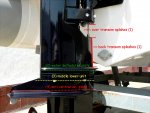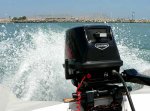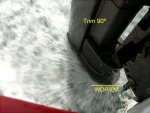Sea Rider
Supreme Mariner
- Joined
- Sep 20, 2008
- Messages
- 12,345
Been doing a exhaustive research on several engine owner brands printed manuals regarding a forum myth near cast on stone and word of mouth recommendation passed from boater to boater through the years that states that all brands AV plates must be even or slight under keel. The research found that this stated myth mentioned to satiety is not so. Each engine brand states different heights ranging from 0 to 40 mm heights during setup installations + poor guidelines that does not say or explain much such as :
-It is your responsibility to choose a boat suitable for the engine, During operation, check to be sure the anti-cavitation plate remains under water at all times.
-The propeller axis must be parallel with water surface, Boat performance depends on outboard mounting height. Make sure the transom height matches the length of the outboard to be installed.
-Test outboard and boat performance at different heights until the best performance is achieved.
Most boaters take for granted that on initial setups all is needed is to sit a given engine brand on a given transom boat model and achieve top water performance on first outing. But years of doing lots of initial setups installations have proven that this is not so.
What does each OB brand states about AV Plate :
Tohatsu, Be sure that the anti ventilation plate of the OB is below the water surface when running with throttle wide open.
Yamaha, ÂThe info is intended as a reference only. Proper mounting depends in part based on proven experience and the specific engine boat combination.ÃÂ Ideal is to find a spot on lower unit height that achieves the least water drag resistance when boat is on plane at speed.
Honda, The anti ventilation plate of the outboard motor should be 2.0 inches below the bottom of the boat.
OMC, The AV plate must be adjusted parallel to boat bottom, not higher than, nor more than 2 inches below it.
ETEC, Generally, the anti-ventilation plate should align with the bottom of the hull.
Suzuki, The Av Plate must be 0 to 1 inch below the bottom of boat.
Bear in mind that S-L lower units of different brands are not same in length, vary slightly from brand to brand. Same applies to boat transom heights differences varying from brand to brand. All of them concludes that top prop thrust is obtained when engine sits at 90 angle on transom and boat rides at speed parallel to water surface.
Continues on 2
-It is your responsibility to choose a boat suitable for the engine, During operation, check to be sure the anti-cavitation plate remains under water at all times.
-The propeller axis must be parallel with water surface, Boat performance depends on outboard mounting height. Make sure the transom height matches the length of the outboard to be installed.
-Test outboard and boat performance at different heights until the best performance is achieved.
Most boaters take for granted that on initial setups all is needed is to sit a given engine brand on a given transom boat model and achieve top water performance on first outing. But years of doing lots of initial setups installations have proven that this is not so.
What does each OB brand states about AV Plate :
Tohatsu, Be sure that the anti ventilation plate of the OB is below the water surface when running with throttle wide open.
Yamaha, ÂThe info is intended as a reference only. Proper mounting depends in part based on proven experience and the specific engine boat combination.ÃÂ Ideal is to find a spot on lower unit height that achieves the least water drag resistance when boat is on plane at speed.
Honda, The anti ventilation plate of the outboard motor should be 2.0 inches below the bottom of the boat.
OMC, The AV plate must be adjusted parallel to boat bottom, not higher than, nor more than 2 inches below it.
ETEC, Generally, the anti-ventilation plate should align with the bottom of the hull.
Suzuki, The Av Plate must be 0 to 1 inch below the bottom of boat.
Bear in mind that S-L lower units of different brands are not same in length, vary slightly from brand to brand. Same applies to boat transom heights differences varying from brand to brand. All of them concludes that top prop thrust is obtained when engine sits at 90 angle on transom and boat rides at speed parallel to water surface.
Continues on 2
Last edited:


























